Continental Growth and Recycling in Convergent Orogens with Large Turbidite Fans on Oceanic Crust
Abstract
:1. Introduction
2. Orogen Architecture

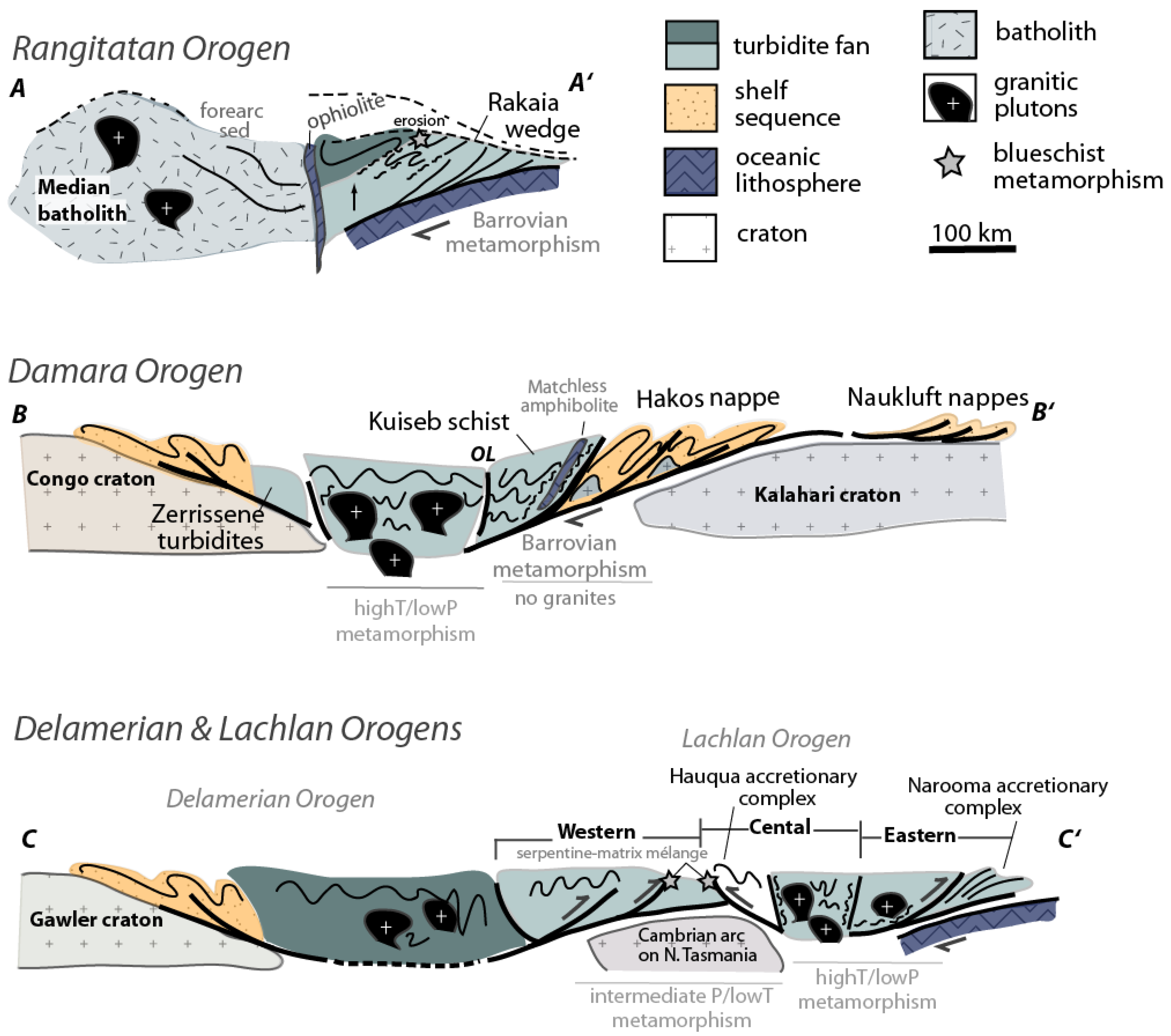
2.1. The Lachlan Orogen, Australia
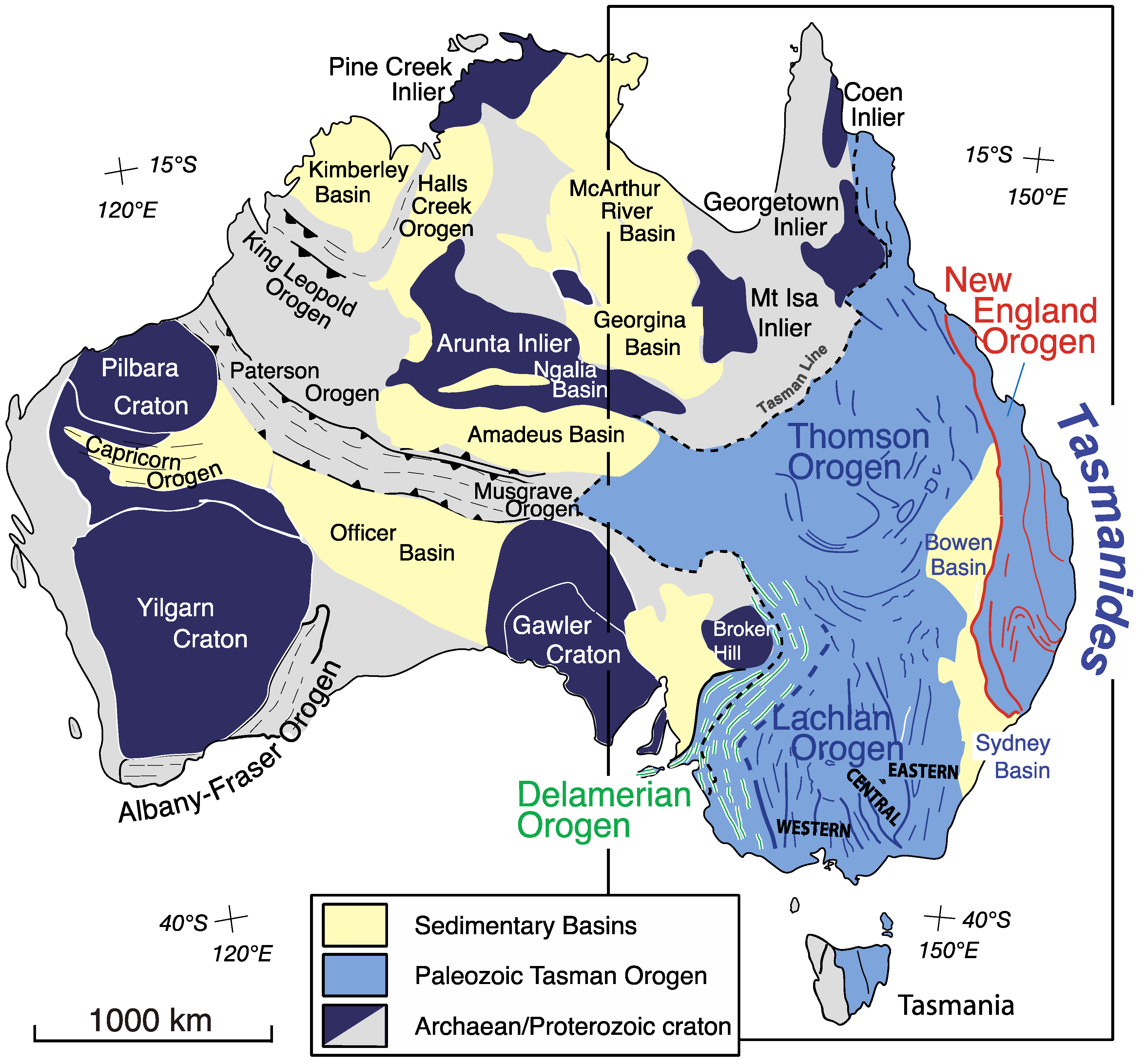
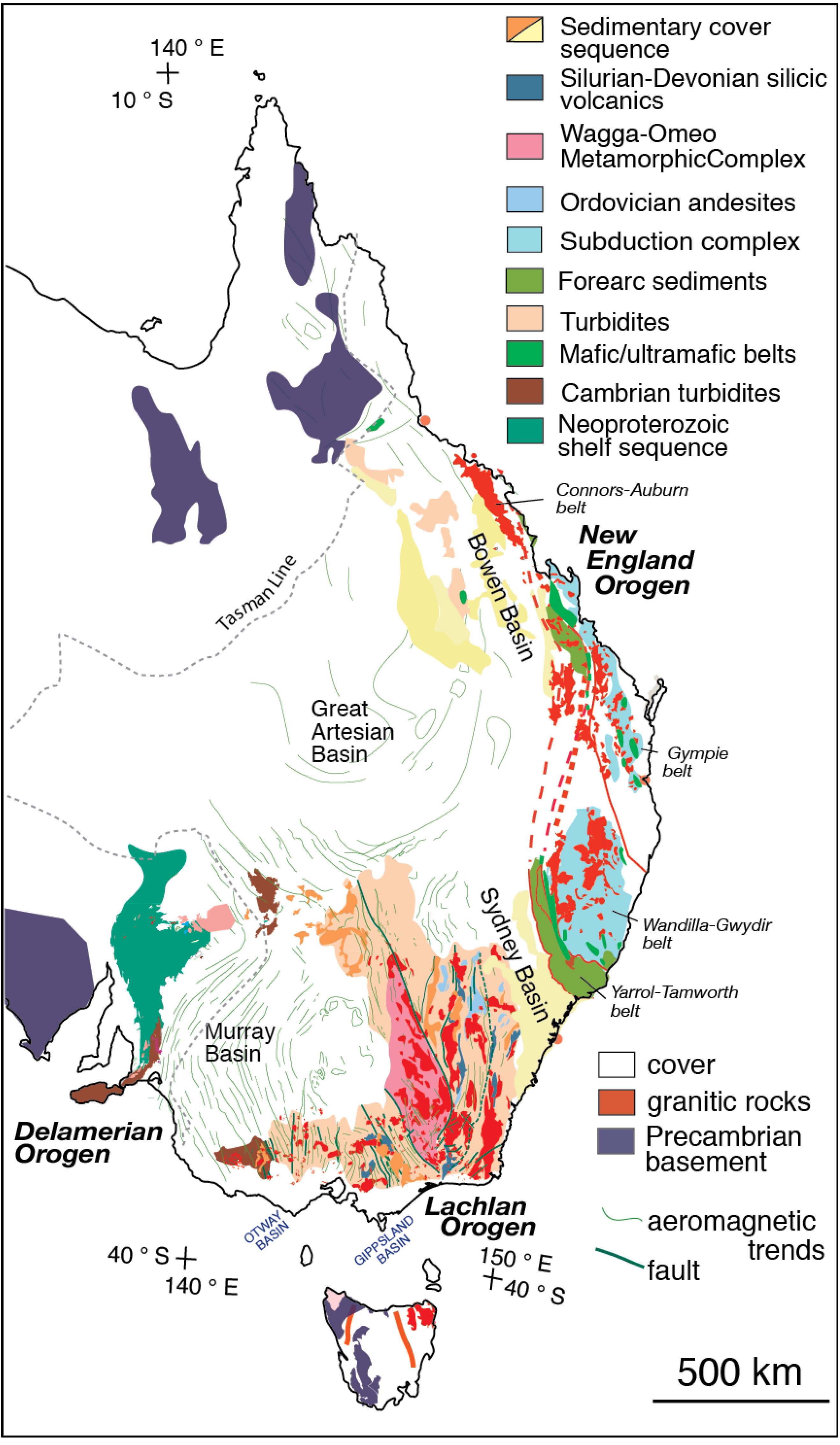
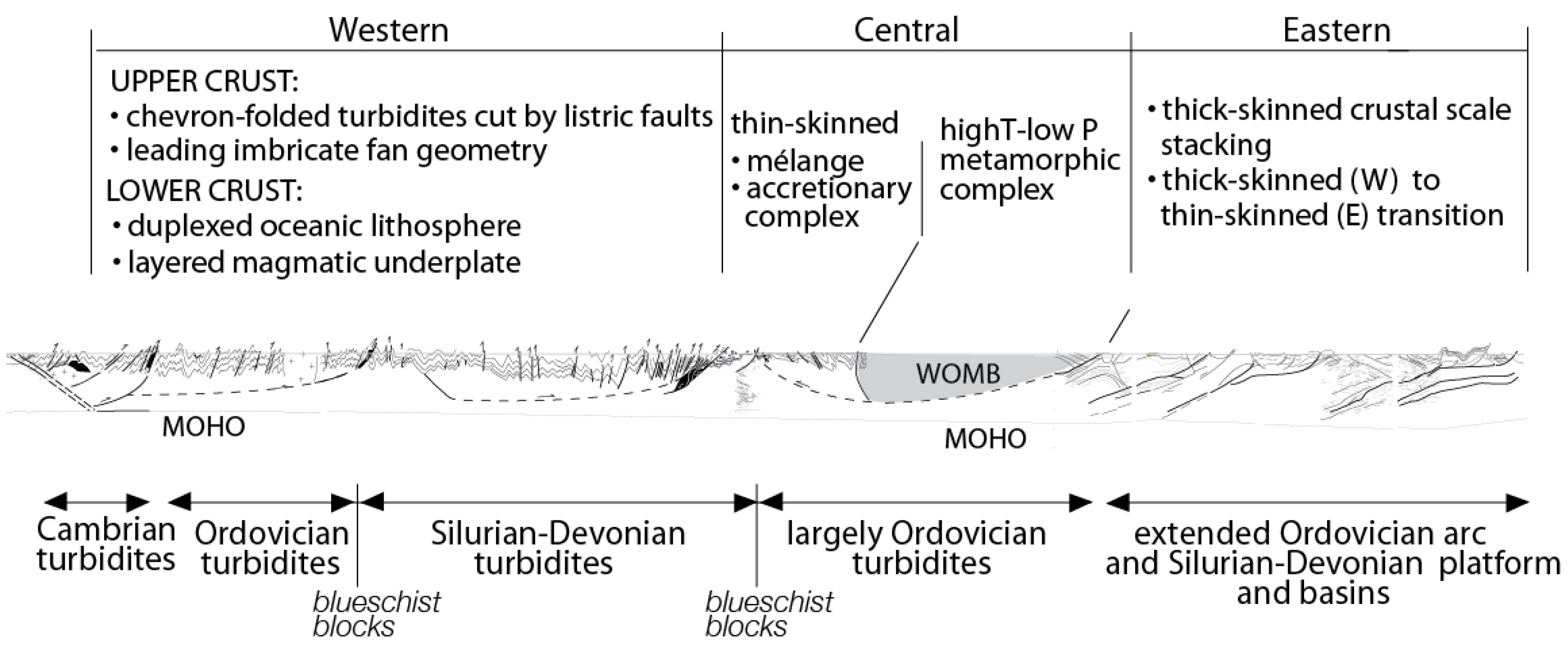
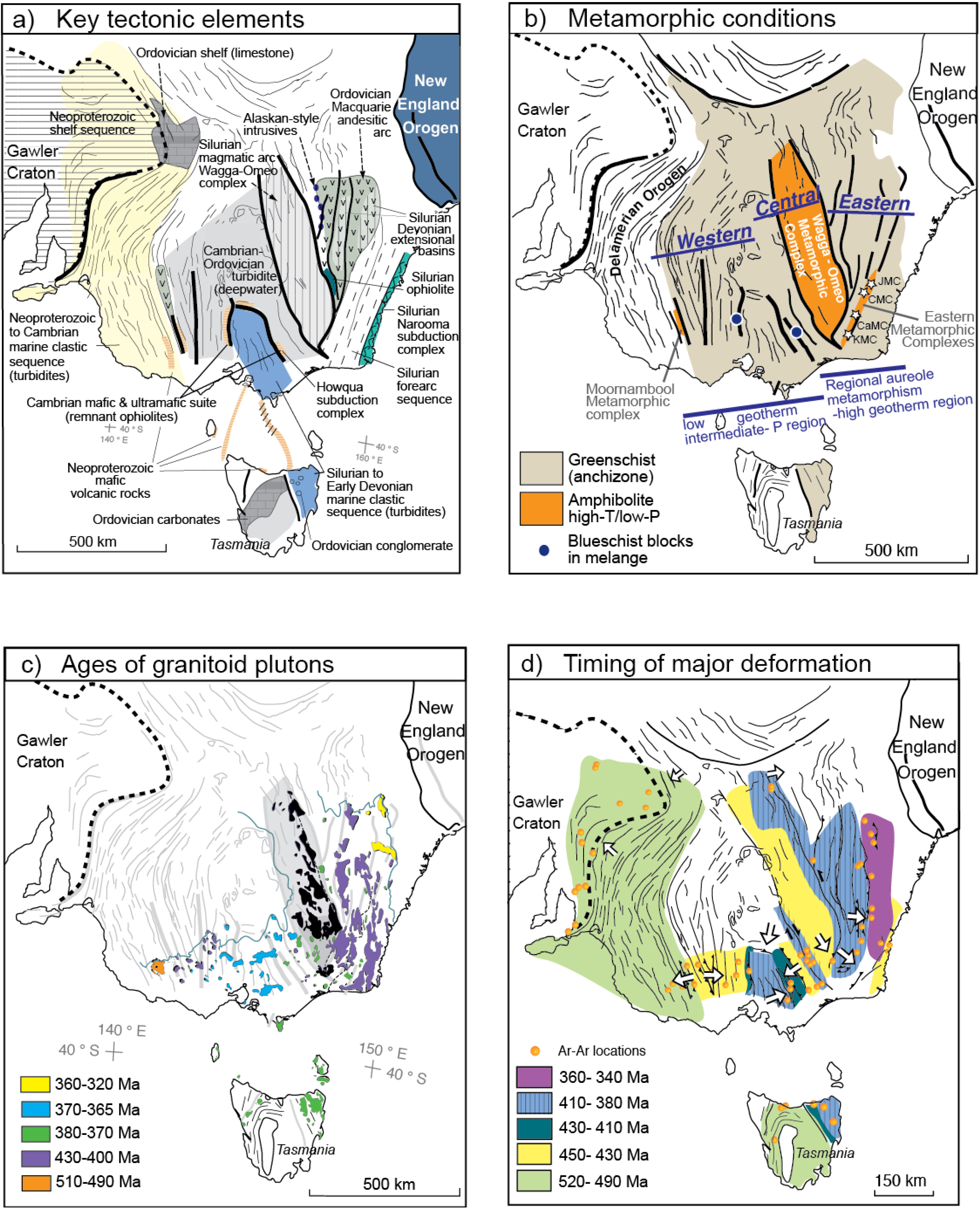
Tectonic Evolution
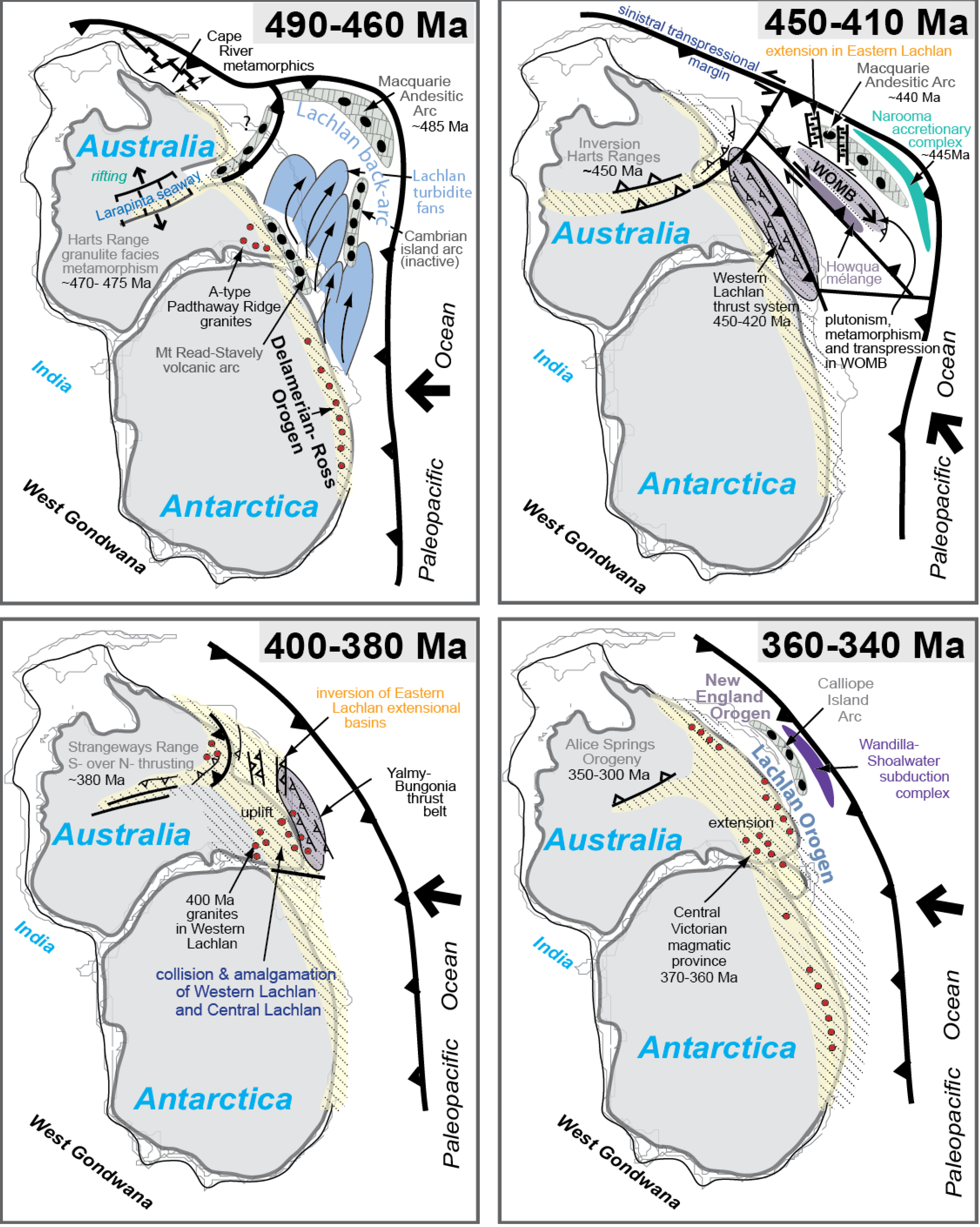

2.2. The Rangitatan Orogen (Rakaia Wedge), New Zealand
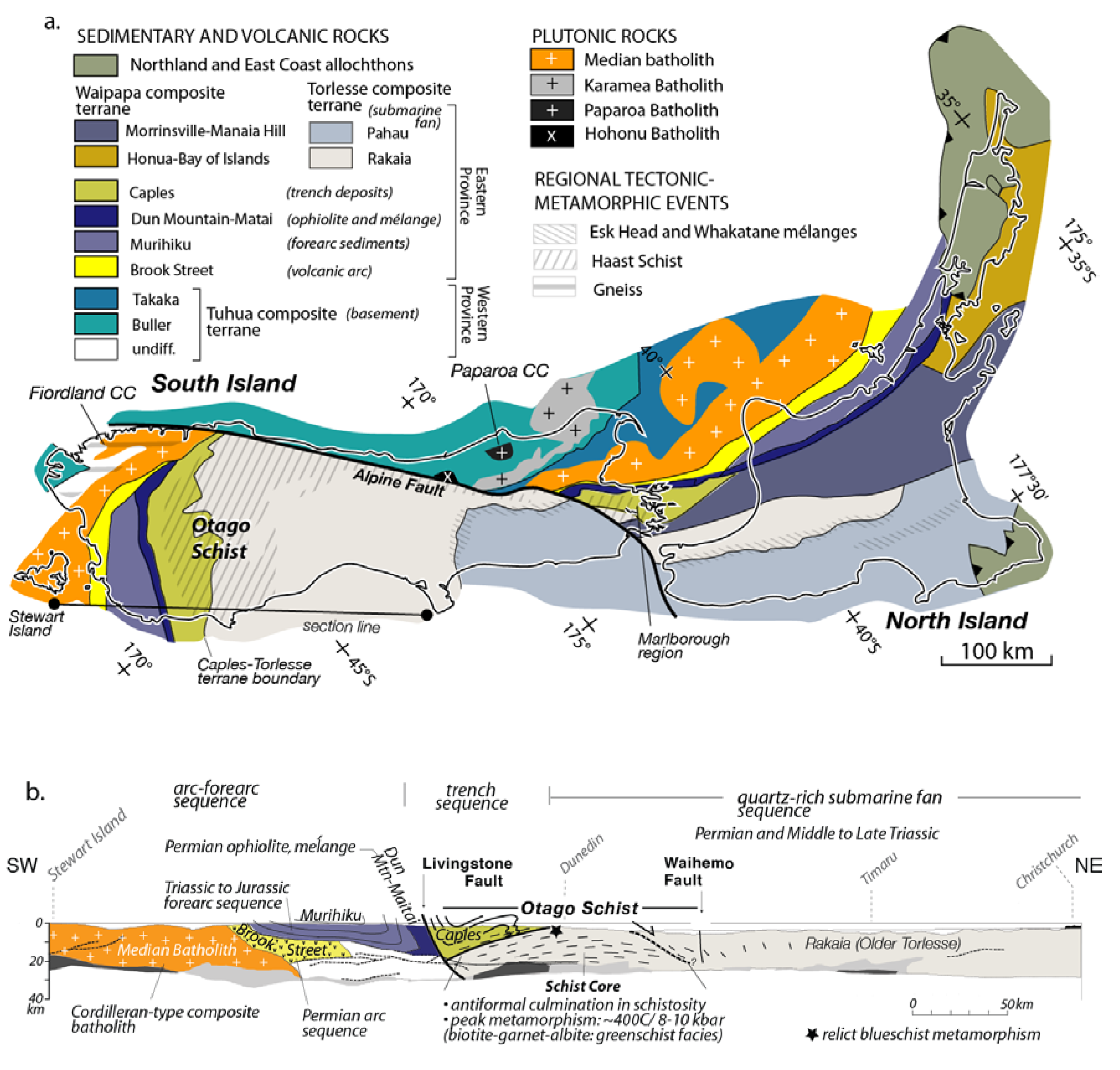

Tectonic Evolution
2.3. The Damara Orogen, Namibia

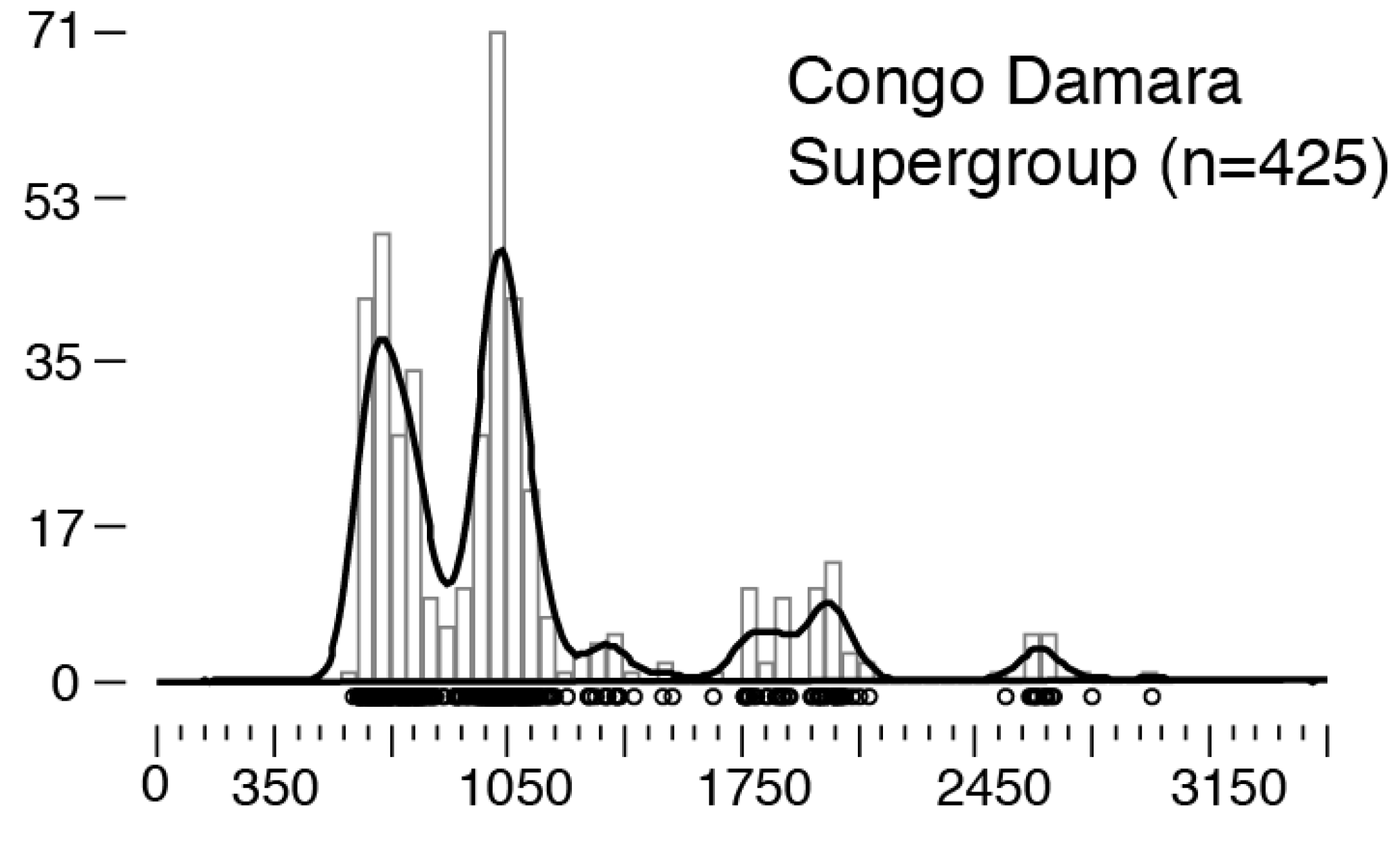

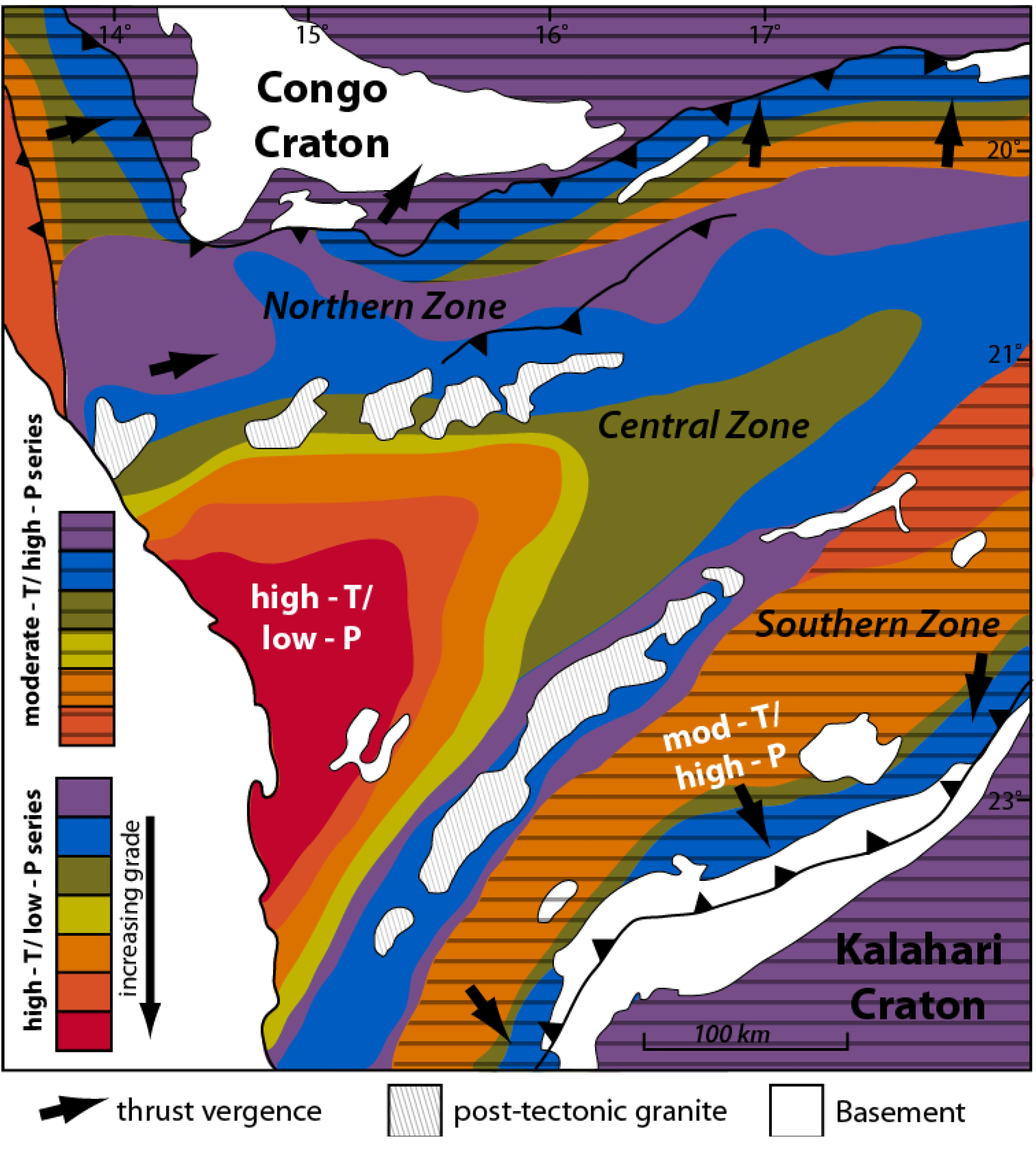

Tectonic Evolution
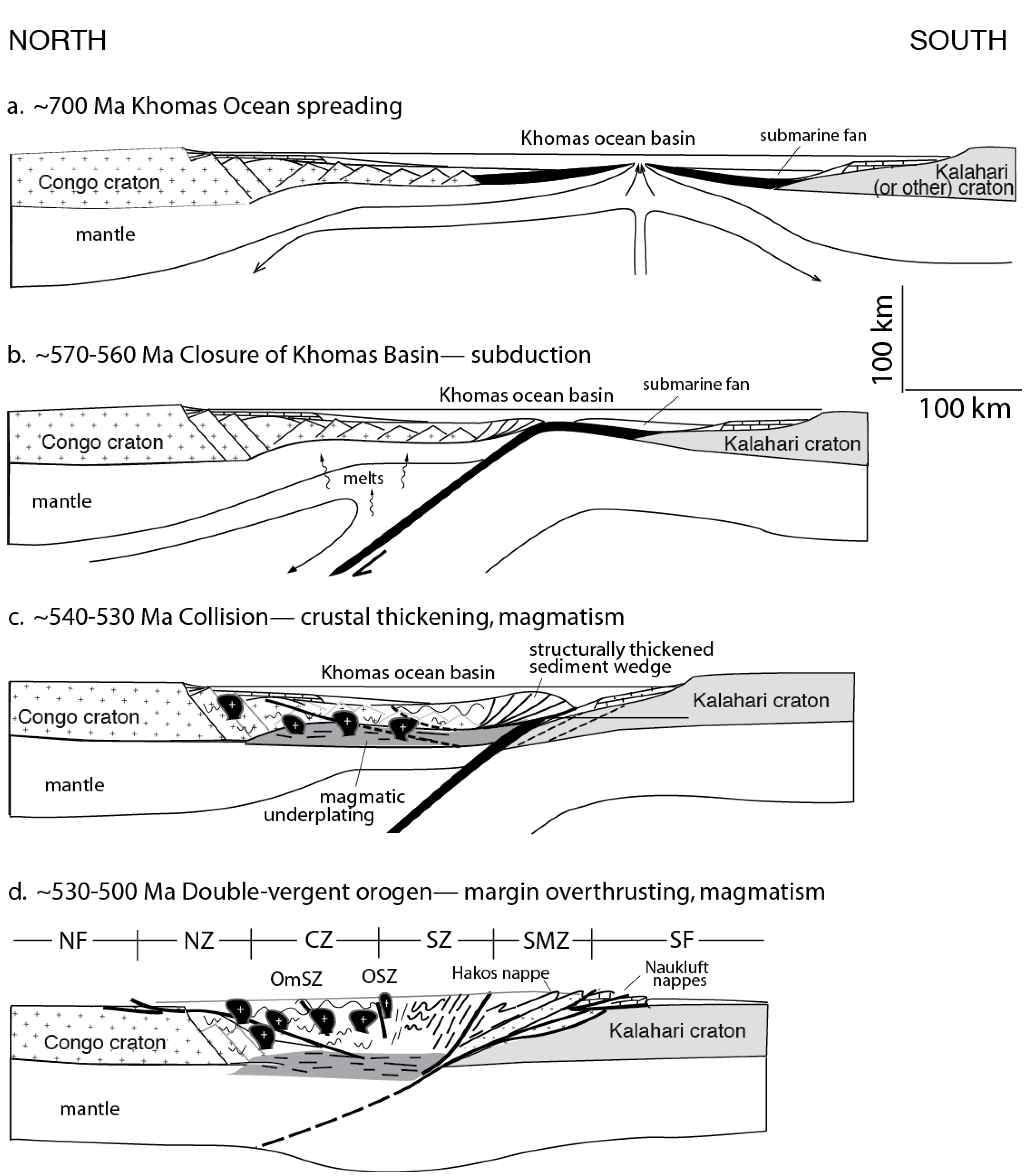
3. Processes of Accretion in Turbidite-Dominated Orogens
3.1. Settings of Turbidites
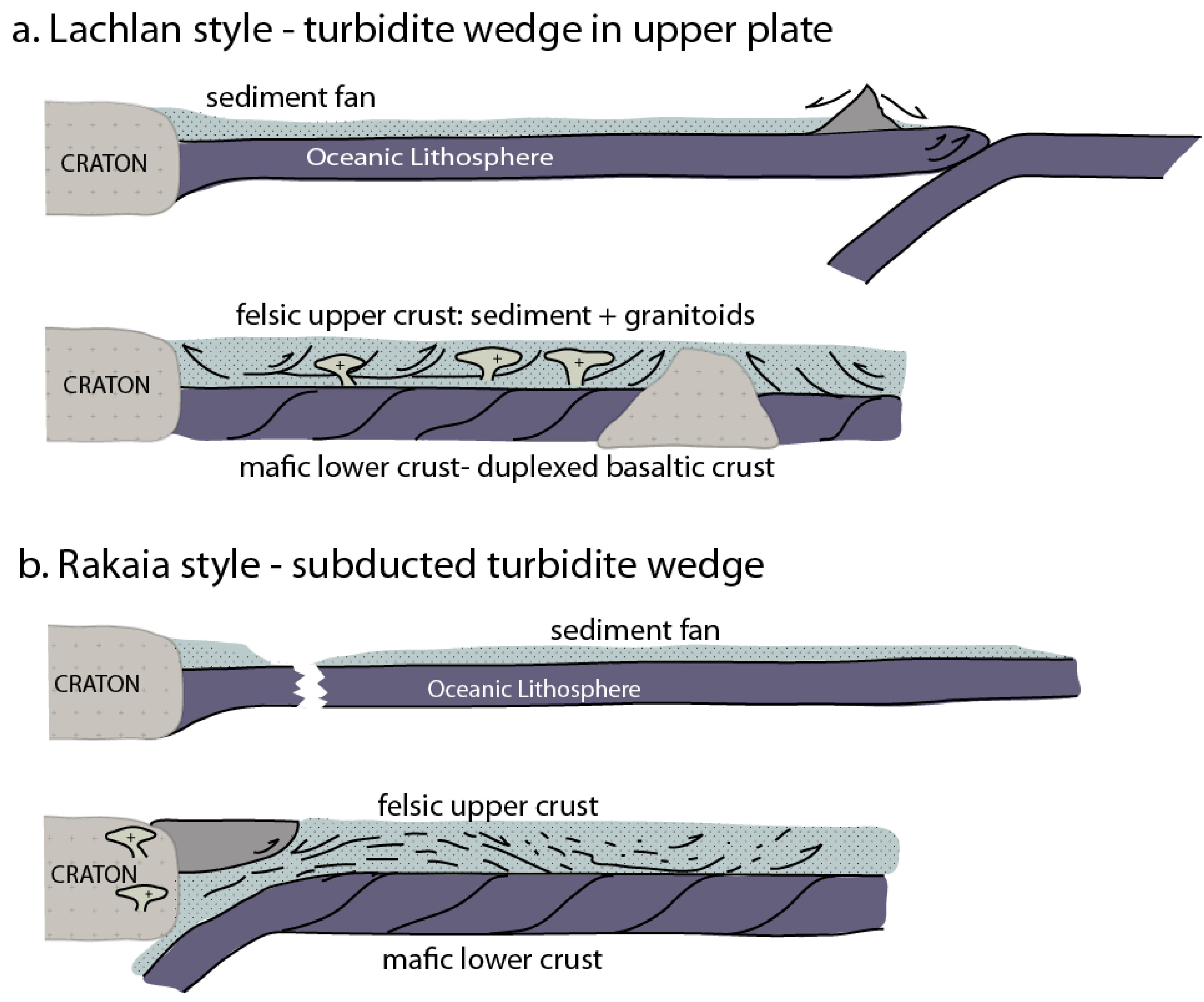
3.2. Significance of Sediment fan Thickness and Timing
3.3. The Template of Accretion
4. Discussion and Conclusions
Acknowledgments
Conflict of Interest
References
- Patchett, P.J.; Bridgwater, D. Origin of continental crust of 1.9–1.7 Ga age defined by Nd isotopes in the Ketilidian terrain of South Greenland. Contrib. Miner. Petrol. 1984, 87, 311–318. [Google Scholar] [CrossRef]
- Foster, D.A.; Gray, D.R. The structure and evolution of the Lachlan Fold Belt (Orogen) of eastern Australia. Annu. Rev. Earth Plan. Sci. 2000, 28, 47–80. [Google Scholar] [CrossRef]
- Kemp, A.I.S.; Hawkesworth, C.J.; Collins, W.J.; Cray, C.M.; Blevin, P.L. Isotopic evidence for rapid growth in an extensional accretionary orogeny: The Tasmanides, eastern Australia. Earth Planet. Sci. Lett. 2009, 284, 455–466. [Google Scholar] [CrossRef]
- Barnes, S.; Sawyer, E. An alternative model for the Damara mobile belt: Ocean crust subduction and continental convergence. Precambrian Res. 1980, 13, 297–336. [Google Scholar] [CrossRef]
- Mortimer, N. New Zealand’s geological foundations. Gondwana Res. 2004, 7, 261–272. [Google Scholar] [CrossRef]
- Mortimer, N. Jurassic tectonic history of the Otago Schist, New Zealand. Tectonics 1993, 12, 237–244. [Google Scholar] [CrossRef]
- Veevers, J.J. Billion-year Earth History of Australia and Neighbours in Gondwanaland; GEMOC Press: Sydney, Australia, 2000. [Google Scholar]
- Gray, D.R.; Foster, D.A. Regional geology: Tasman Orogen, Australia. Encycl. Geol. 2004, 1, 237–252. [Google Scholar]
- Glen, R.A. The Tasmanides of eastern Australia. Geol. Soc. Lond. Spec. Publ. 2005, 246, 23–96. [Google Scholar] [CrossRef]
- Fergusson, C.L.; Coney, P.J. Implications of a Bengal Fan-type deposit in the Paleozoic Lachlan fold belt of southeastern Australia. Geology 1992, 20, 1047–1049. [Google Scholar] [CrossRef]
- Powell, C.McA. Tectonic relationship between the late Ordovician and Late Silurian palaeogeographies of southeastern Australia. J. Geol. Soc. Aust. 1983, 30, 353–373. [Google Scholar] [CrossRef]
- Vandenberg, A.H.M.; Stewart, I.R. Ordovician terranes of the southeastern Lachlan Fold Belt: Stratigraphy, structure and palaeogeographic reconstruction. Tectonophysics 1992, 214, 159–176. [Google Scholar] [CrossRef]
- Gray, C.M.; Webb, J. Provenance of Palaeozoic turbidites in the Lachlan Orogenic Belt: Strontium isotopic evidence. Aust. J. Earth Sci. 1995, 42, 95–105. [Google Scholar] [CrossRef]
- Fergusson, C.L.; Fanning, C.M. Late Ordovician stratigraphy, zircon provenance and tectonics, Lachlan Fold Belt, southeastern Australia. Aust. J. Earth Sci. 2002, 49, 423–436. [Google Scholar] [CrossRef]
- Turner, S.P.; Kelley, S.P.; VandenBerg, A.H.M.; Foden, J.; Sandiford, M.; Flöttmann, T. Source of the Lachlan fold belt flysch linked to convective removal of the lithospheric mantle and rapid exhumation of the Delamerian-Ross fold belt. Geology 1996, 24, 941–944. [Google Scholar] [CrossRef]
- Crawford, A.J.; Keays, R.R. Cambrian greenstone belts in Victoria: Marginal sea crust slices in the Lachlan Fold Belt of southeastern Australia. Earth Planet. Sci. Lett. 1978, 41, 197–208. [Google Scholar] [CrossRef]
- Crawford, A.J.; Keays, R.R. Petrogenesis of Victorian Cambrian tholeiites and implications for the origin of associated boninites. J. Pet. 1987, 28, 1075–1109. [Google Scholar] [CrossRef]
- Foster, D.A.; Gray, D.R.; Spaggiari, C.; Kamenov, G.; Bierlein, F.P. Palaeozoic Lachlan Orogen, Australia; accretion and construction of continental crust in a marginal ocean setting: Isotopic evidence from Cambrian metavolcanic rocks. Geol. Soc. Lond. Spec. Publ. 2009, 318, 329–349. [Google Scholar] [CrossRef]
- Gray, D.R.; Foster, D.A. Tectonic evolution of the Lachlan Orogen, southeast Australia: Historical review, data synthesis and modern perspectives. Aust. J. Earth Sci. 2004, 51, 773–817. [Google Scholar] [CrossRef]
- Spaggiari, C.V.; Gray, D.R.; Foster, D.A. Ophiolite accretion in the Lachlan Orogen, southeastern Australia. J. Struct. Geol. 2004, 6, 87–112. [Google Scholar] [CrossRef]
- Offler, R.; McKnight, S.; Morand, V. Tectonothermal history of the western Lachlan Fold Belt, Australia: Insights from white mica studies. J. Metamorph. Geol. 1998, 16, 531–540. [Google Scholar]
- Spaggiari, C.V.; Gray, D.R.; Foster, D.A.; McKnight, S. Evolution of the boundary between the western and central Lachlan Orogen: Implications for Tasmanide tectonics. Aust. J. Earth Sci. 2003, 50, 725–749. [Google Scholar] [CrossRef]
- Fergusson, C.L. Early Palaeozoic backarc deformation in the Lachlan Fold Belt, southeastern Australia: Implications for terrane translations in eastern Gondwanaland. Geodyn. Ser. 1987, 19, 39–56. [Google Scholar] [CrossRef]
- Miller, J.McL.; Gray, D.R. Subduction related deformation and the Narooma anticlinorium, eastern Lachlan Orogen. Aust. J. Earth Sci. 1997, 44, 237–251. [Google Scholar] [CrossRef]
- Watson, J.M.; Gray, D.R. Character, extent and significance of broken formation for the Tabberabbera Zone, central Lachlan Orogen. Aust. J. Earth Sci. 2001, 48, 943–954. [Google Scholar] [CrossRef]
- Spaggiari, C.V.; Gray, D.R.; Foster, D.A. Blueschist metamorphism during accretion in the Lachlan Orogen, southeastern Australia. J. Metamorph. Geol. 2002, 20, 711–726. [Google Scholar] [CrossRef]
- Spaggiari, C.V.; Gray, D.R.; Foster, D.A.; Fanning, C.M. Occurrence and significance of blueschists in the southern Lachlan Orogen. Aust. J. Earth Sci. 2002, 49, 255–269. [Google Scholar] [CrossRef]
- Morand, V.J. Low-pressure regional metamorphism in the Omeo Metamorphic Complex, Victoria, Australia. J. Metamorph. Geol. 1990, 8, 1–12. [Google Scholar] [CrossRef]
- Collins, W.J.; Hobbs, B.E. What caused the Early Silurian change from mafic to silicic magmatism in the eastern Lachlan Fold Belt? Aust. J. Earth Sci. 2001, 48, 25–41. [Google Scholar] [CrossRef]
- Gray, D.R.; Foster, D.A.; Maas, R.; Spaggiari, C.V.; Gregory, R.T.; Goscombe, B.D.; Hoffmann, K.H. Continental growth and recycling by accretion of deformed turbidte fans and remnant ocean basins: Examples from Neoproterozoic and Phanerozoic orogens. Geol. Soc. Am. Mem. 2007, 200, 63–92. [Google Scholar] [CrossRef]
- Foster, D.A.; Gray, D.R.; Bucher, M. Chronology of deformation within the turbidite-dominated Lachlan orogen: Implications for the tectonic evolution of eastern Australia and Gondwana. Tectonics 1999, 18, 452–485. [Google Scholar] [CrossRef]
- Spaggiari, C.V.; Gray, D.R.; Foster, D.A. Tethyan and Cordilleran-Type Ophiolites of Eastern Australia: implications for the evolution of the Tasmanides. Geol. Soc. Lond. Spec. Publ. 2003, 218, 517–539. [Google Scholar] [CrossRef]
- White, A.J.R.; Chappell, B.W. Granitoid types and their distribution in the Lachlan Fold Belt, SE Australia. Geol. Soc. Am. Mem. 1983, 159, 21–34. [Google Scholar]
- Chappell, B.W.; White, A.J.R.; Hine, R. Granite provinces and basement terranes in the Lachlan Fold Belt, southeastern Australia. Aust. J. Earth Sci. 1988, 35, 505–521. [Google Scholar] [CrossRef]
- Hine, R.; Williams, I.S.; Chappell, B.W.; White, A.J.R. Contrasts between I- and S-type granitoids of the Kosciusko Batholith. J. Geol. Soc. Aust. 1978, 25, 219–234. [Google Scholar] [CrossRef]
- Keay, S.; Steele, D.; Compston, W. Identifying granite sources by SHRIMP U–Pb zircon geochronology: An application to the Lachlan Fold Belt. Contrib. Miner. Petrol. 2000, 137, 323–341. [Google Scholar] [CrossRef]
- Glen, R.A.; Walshe, J.L.; Barron, L.M.; Watkins, J.J. Ordovician convergent margin volcanism and tectonism in the Lachlan sector of east Gondwana. Geology 1998, 26, 751–754. [Google Scholar] [CrossRef]
- Glen, R.A.; Crawford, A.J.; Percival, I.G.; Barron, L.M. Early Ordovician development of the Macquarie Arc, Lachlan Orogen, New South Wales. Aust. J. Earth Sci. 2007, 54, 167–179. [Google Scholar] [CrossRef]
- Price, R.C.; Brown, W.M.; Woolard, C.A. The geology, geochemistry and origin of late-Silurian, high-Si igneous rocks of the upper Murray Valley, NE Victoria. J. Geol. Soc. Austr. 1983, 30, 443–459. [Google Scholar] [CrossRef]
- Phillips, G.N.; Wall, V.J.; Clemens, J.C. Petrology of the Strathbogie Batholith—A cordierite-bearing granite. Can. Miner. 1981, 19, 47–63. [Google Scholar]
- Clemens, J.D.; Wall, V.J. Origin and evolution of a peraluminous silicic ignimbrite suite: The Violet Town Volcanics. Contrib. Miner. Petrol. 1984, 88, 354–371. [Google Scholar] [CrossRef]
- Rossiter, A.G. Granitic rocks of the Lachlan Gold Belt in Victoria. Geol. Soc. Aust. Spec. Publ. 2003, 23, 217–237. [Google Scholar]
- Collins, W.J.; Beams, S.D.; White, A.J.R.; Chappell, B.W. Nature and origin of A-type granites with particular reference to southeastern Australia. Contrib. Miner. Petrol. 1982, 80, 189–200. [Google Scholar] [CrossRef]
- McCulloch, M.T.; Chappell, B.W. Nd isotopic characteristics of S- and I-type granites. Earth Planet. Sci. Lett. 1982, 58, 51–64. [Google Scholar] [CrossRef]
- Keay, S.; Collins, W.J.; McCulloch, M.T. A three-component isotopic mixing model for granitoid genesis, Lachlan fold belt, eastern Australia. Geology 1997, 25, 307–310. [Google Scholar] [CrossRef]
- Adams, C.J.; Pankhurst, R.J.; Maas, R.; Millar, I.L. Nd and Sr isotopic signatures of metasedimentary terranes around the South Pacific margin, and implications for their provenance. Geol. Soc. Lond. Spec. Publ. 2005, 246, 113–142. [Google Scholar] [CrossRef]
- Kemp, A.I.S.; Hawkesworth, C.J.; Foster, G.L.; Paterson, B.A.; Woodhead, J.D.; Hergt, J.M.; Gray, C.M. Magmatic and crustal differentiation history of granitic rocks from Hf–O Isotopes in zircon. Science 2007, 315, 980–983. [Google Scholar] [CrossRef]
- Williams, I.S. Some observations on the use of zircon U–Pb geochronology in the study of granitic rocks. Trans. R. Soc. Ed. 1992, 83, 447–458. [Google Scholar] [CrossRef]
- Bierlein, F.P.; Hughes, M.; Dunphy, J.; McKnight, S.; Reynolds, P.; Waldron, H. Tectonic and economic implications of trace element, 40Ar/39Ar and Sm–Nd data from mafic dykes associated with orogenic gold mineralisation in central Victoria, Australia. Lithos 2001, 18, 1–31. [Google Scholar]
- Maas, R.; Nicholls, I.A.; Greig, A.; Nemchin, A. U–Pb zircon studies of mid-crustal metasedimentary enclaves from the S-type Deddick Granodiorite, Lachlan Fold Belt, SE Australia. J. Pet. 2001, 42, 1429–1448. [Google Scholar] [CrossRef]
- Soesoo, A.; Bons, P.D.; Gray, D.R.; Foster, D.A. Divergent double subduction: Tectonic and petrologic consequences. Geology 1997, 25, 755–758. [Google Scholar] [CrossRef]
- Soesoo, A.; Nicholls, I.A. Mafic rocks spatially associated with Devonian felsic intrusions of the southern Lachlan Fold Belt: A possible mantle contribution to crustal evolution processes. Aust. J. Earth Sci. 1999, 46, 725–734. [Google Scholar]
- Gray, C.M. An isotopic mixing model for the origin of granitic rocks in southeastern Australia. Earth Plan. Sci. Lett. 1984, 70, 47–60. [Google Scholar] [CrossRef]
- Gray, C.M. A strontium isotopic traverse across the granitic rocks of southeastern Australia: Petrogenetic and tectonic implications. Aust. J. Earth Sci. 1990, 37, 331–349. [Google Scholar] [CrossRef]
- Collins, W.J. Lachlan Fold Belt granitoids: Products of three-component mixing. Trans. R. Soc. Ed. Earth Sci. 1996, 87, 171–182. [Google Scholar] [CrossRef]
- Collins, W.J. Evaluation of petrogenetic models for Lachlan Fold Belt granitoids: Implications for crustal architecture and tectonic models. Aust. J. Earth Sci. 1998, 45, 483–500. [Google Scholar] [CrossRef]
- Foster, D.A.; Gray, D.R.; Spaggiari, C.V. Timing of subduction and exhumation along the Cambrian East Gondwana margin, and the formation of Paleozoic back-arc basins. Geol. Soc. Am. Bull. 2005, 117, 105–116. [Google Scholar] [CrossRef]
- Foster, D.A.; Gray, D.R. Paleozoic crustal growth, structure, strain rate, and metallogeny in the Lachlan Orogen, Eastern Australia. Ariz Geol. Soc. Dig. 2008, 22, 213–225. [Google Scholar]
- Gray, D.R.; Foster, D.A.; Bucher, M. Recognition and definition of orogenic events in the Lachlan Fold Belt. Aust. J. Earth Sci. 1997, 44, 489–581. [Google Scholar] [CrossRef]
- Spaggiari, C.V.; Gray, D.R.; Foster, D.A. Lachlan Orogen subduction-accretion systematics revisited. Austr. J. Earth Sci. 2004, 51, 549–553. [Google Scholar] [CrossRef]
- Collins, W.J. Nature of extensional accretionary orogens. Tectonics 2002, 21, 1024–1036. [Google Scholar] [CrossRef]
- Coombs, D.S.; Landis, C.A.; Norris, R.J.; Sinton, J.M.; Borns, D.J.; Craw, D. The Dun Mountain Ophiolite belt, New Zealand, its tectonic setting, constitution, and origin, with special reference to the southern portion. Am. J. Sci. 1976, 276, 561–603. [Google Scholar] [CrossRef]
- Bradshaw, J.D. Cretaceous geotectonic patterns in the New Zealand region. Tectonics 1989, 8, 803–820. [Google Scholar] [CrossRef]
- Adams, C.J.; Barley, M.E.; Fletcher, I.R.; Pickard, A.L. Evidence from U–Pb zircon and 40Ar/39Ar muscovite detrital mineral ages in metasandstones for movement of the Torlesse suspect terrane around the eastern margin of Gondwanaland. Terra Nova 1998, 10, 183–189. [Google Scholar] [CrossRef]
- Adams, C.J.; Cambell, H.J.; Griffin, W.L. Provenance comparisons of Permian to Jurassic tectostratigraphic terranes in New Zealand: Perspectives from detrital zircon age patterns. Geol. Mag. 2007, 144, 701–729. [Google Scholar] [CrossRef]
- Gray, D.R.; Foster, D.A. 40Ar/39Ar thermochronologic constraints on deformation, metamorphism and cooling/exhumation of a Mesozoic accretionary wedge, Otago Schist, New Zealand. Tectonophysics 2004, 385, 181–210. [Google Scholar] [CrossRef]
- Mortimer, N.; Davey, F.J.; Melhush, A.; Yu, J.; Godfrey, N.J. Geological interpretation of a deep crustal seismic reflection profile across the eastern Province and Median Batholith, New Zealand: Crustal architecture of an extended Phanerozoic convergent orogeny. N. Z. J. Geol. Geophys. 2003, 45, 349–363. [Google Scholar]
- Cawood, P.A. Stratigraphic and structural relations of strata enclosing the Dun Mountain ophiolite belt in the Arthurton-Clinton region, Southland. N. Z. J. Geol. Geophys. 1987, 30, 19–36. [Google Scholar]
- Norris, R.J.; Craw, D. Aspiring terrane: an oceanic assemblage from New Zealand and its implications for Mesozoic terrane accretion in the southwest Pacific. Am. Geophys. Union Geodyn. Ser. 1987, 19, 169–177. [Google Scholar]
- Mortimer, N. Metamorphic discontinuities in orogenic belts: Example of garnet–biotite–albite zone in the Otago Schist, New Zealand. Int. J. Earth Sci. 2000, 89, 295–306. [Google Scholar] [CrossRef]
- Yardley, B.W.D. The early metamorphic history of the Haast Schists and related rocks of New Zealand. Contrib. Miner. Petrol. 1982, 81, 317–327. [Google Scholar] [CrossRef]
- Mortimer, N.; Tulloch, A.J.; Spark, R.N.; Walker, N.W.; Ladley, E.; Allibone, A.; Kimbrough, D.L. Overview of the Median Batholith, New Zealand: A new interpretation of the geology of the Median Tectonic Zone and adjacent rocks. J. Afr. Earth Sci. 1999, 29, 259–270. [Google Scholar]
- Kimbrough, D.L.; Tulloch, A.J.; Geary, E.; Coombs, D.S.; Mattinson, J.M. Isotopic ages from the Nelson region of the South Island, New Zealand: Crustal structure and definition of the Median Tectonic Zone. Tectonophysics 1993, 225, 433–448. [Google Scholar] [CrossRef]
- Kimbrough, D.L.; Tulloch, A.J.; Coombs, D.S.; Landis, C.A.; Johnston, M.R.; Mattison, J.M. Uranium-lead ages from the Median Tectonic Zone, South Island New Zealand. N. Z. J. Geol. Geophys. 1994, 37, 393–419. [Google Scholar] [CrossRef]
- Muir, R.J.; Ireland, T.R.; Weaver, S.D.; Bradshaw, J.D.; Evans, J.A.; Eby, G.N.; Shelley, D. Geochronology and geochemistry of a Mesozoic magmatic arc system, Fiordland, New Zealand. J. Geol. Soc. Lond. 1998, 155, 1037–1053. [Google Scholar] [CrossRef]
- Mortimer, N.; Gans, P.; Calvert, A.; Walker, N. Geology and thermochronometry of the east edge of the Median Batholith (Median Tectonic Zone): A new perspective on Permian to Cretaceous crustal growth of New Zealand. Island Arc 1999, 8, 404–425. [Google Scholar] [CrossRef]
- McCulloch, M.T.; Bradshaw, J.Y.; Taylor, S.R. Sm–Nd and Rb–Sr isotopic and geochemical systematics in Phanerozoic granulites from Fiordland, southwest New Zealand. Contrib. Miner. Petrol. 1987, 97, 183–195. [Google Scholar] [CrossRef]
- Muir, R.J.; Weaver, S.D.; Bradshaw, J.D.; Eby, G.N.; Evans, J.A. The Cretaceous Separation Point Batholith, New Zealand. Granitoid magmas formed by melting of mafic lithosphere. J. Geol. Soc. Lond. 1995, 152, 689–701. [Google Scholar]
- Klepeis, K.A.; Clarke, G.L.; Rushmer, T. Magma transport and coupling between deformation and magmatism in the continental lithosphere. GSA Today 2003, 13, 4–11. [Google Scholar] [CrossRef]
- Wandres, A.M.; Bradshaw, J.D. New Zealand tectonostratigraphy and implications from conglomeratic rocks for the configuration of the SW Pacific margin of Gondwana. Geol. Soc. Lond. Spec. Publ. 2005, 246, 179–216. [Google Scholar] [CrossRef]
- Tulloch, A.J. Batholiths, plutons and suites: Nomenclature for granitoid rocks of Westland-Nelson, New Zealand. N. Z. J. Geol. Geophys. 1988, 31, 505–509. [Google Scholar] [CrossRef]
- Waight, T.E.; Weaver, S.D.; Muir, J.; Maas, R.; Eby, N. The Hohonu Batholith of North Westland, New Zealand: Granitoid compositions controlled by source H2O contents and generated during tectonic transition. Contrib. Miner. Petrol. 1998, 130, 225–239. [Google Scholar]
- Tulloch, A.J.; Kimbrough, D.L. The Paparoa Metamorphic Core Complex, New Zealand: Cretaceous extension associated with fragmentation of the Pacific margin of Gondwana. Tectonics 1989, 8, 1217–1234. [Google Scholar] [CrossRef]
- Waight, T.E.; Weaver, S.D.; Muir, R.J. Mid-Cretaceous granitic magmatism dating the transition from subduction to extension in southern New Zealand: A chemical and tectonic synthesis. Lithos 1998, 45, 469–482. [Google Scholar] [CrossRef]
- Roser, B.; Cooper, A.F. Geochemistry and terrane affiliation of Haast Schist from the western Southern Alps, New Zealand. N. Z. J. Geol. Geophys. 1990, 94, 635–650. [Google Scholar]
- Prave, A.R. Tale of three cratons: Tectostratigraphic anatomy of the Damara Orogen in northwestern Namibia and the assembly of Gondwana. Geology 1996, 24, 1115–1118. [Google Scholar] [CrossRef]
- Martin, H.; Porada, H. The intracratonic branch of the Damara Orogen in South West Africa: I. Discussion of Geodynamic models. Precambrian Res. 1977, 5, 311–338. [Google Scholar] [CrossRef]
- Hoffmann, K.-H. Lithostratigraphy and facies of the Swakop Group of the southern Damara belt, SWA/Namibia. Geol. Soc. S. Afr. Spec. Publ. 1983, 11, 43–63. [Google Scholar]
- Miller, R.McL. The Pan-African Damara orogen of South West Namibia/Africa. Geol. Soc. S. Afr. Spec. Publ. 1983, 11, 431–515. [Google Scholar]
- Kukla, P.A.; Stanistreet, I.G. Record of the Damaran Khomas Hochland accretionary prism in central Namibia: Refutation of an “ensialic” origin of a Late Proterozoic orogenic belt. Geology 1991, 19, 473–476. [Google Scholar]
- Gray, D.R.; Foster, D.A.; Goscombe, B.; Passchier, C.W.; Trouw, R.A.J. 40Ar/39Ar thermochronology of the Pan-African Damara Orogen, Namibia with implications for tectonothermal and geodynamic evolution. Precambrian Res. 2006, 150, 49–72. [Google Scholar] [CrossRef]
- Foster, D.A.; Goscombe, B.D.; Newstead, B.L.; Muvangua, E.; Mueller, P.A.; Mapani, B. Rodinia-Gondwana supercontinent cycle refined by detrital zircons from the Damara Orogen. In Proceedings of 2012 Geological Society of America Annual Meeting, Charlotte, NC, USA, 4–7 November 2012; p. 175.
- Barnes, S. Pan-African serpentinites in central south west Africa/Namibia and the chemical classification of serpentinites. Geol. Soc. S. Afr. Spec. Publ. 1983, 11, 147–155. [Google Scholar]
- Schmidt, A.; Wedepohl, K.H. Chemical composition and genetic relations of the Matchless Amphibolite (Damara Orogenic Belt). Geol. Soc. S. Afr. Spec. Publ. 1983, 11, 139–145. [Google Scholar]
- Killick, A.M. The Matchless Belt and associated sulphide mineral deposits, Damara Orogen, Namibia. Commun. Geol. Surv. Namib. 2000, 12, 73–80. [Google Scholar]
- Kisters, A.F.M.; Jordaan, L.S.; Neumaier, K. Thrust-related dome structures in the Karibib district and the origin of orthogonal fabric domains in the south Central Zone of the Pan-African Damara belt, Namibia. Precambrian Res. 2004, 133, 283–303. [Google Scholar] [CrossRef]
- Jacob, R.E.; Moore, J.M.; Armstrong, R.A. Zircon and titanite age determinations from igneous rocks in the Karibib District, Namibia; implications for Navachab vein-style gold mineralization. Commun. Geol. Surv. Namib. 2000, 12, 157–166. [Google Scholar]
- De Kock, G.S.; Eglington, B.; Armstrong, R.A.; Hermer, R.E.; Walraven, F. U–Pb and Pb–Pb ages of the Naauwpoort Rhyolite, Kawakeup leptite and Okongava Diorite: Implications for the onset of rifting and of orogenesis in the Damara Belt, Namibia. Commun. Geol. Surv. Namib. 2000, 12, 81–88. [Google Scholar]
- Jung, S.; Mezger, K. U–Pb garnet chronometry in high-grade rocks; case studies from the central Damara Orogen (Namibia) and implications for the interpretation of Sm–Nd garnet ages and the role of high U–Th inclusions. Contrib. Miner. Petrol. 2003, 146, 382–396. [Google Scholar]
- Jung, S.; Mezger, K. Petrology of basement-dominated terranes. I: Regional metamorphic T-t path from U–Pb monazite and Sm–Nd garnet geochronology (central Damara Orogen, Namibia). Chem. Geol. 2003, 198, 223–247. [Google Scholar]
- Schmitt, R.S.; Trouw, R.A.J.; Passchier, C.W.; Medeiros, S.R.; Armstrong, R. 530 Ma syntectonic syenites and granites in NW Namibia—Their relation with collision along the junction of the Damara and Kaoko belts. Gondwana Res. 2012, 21, 362–377. [Google Scholar]
- Longridge, L.; Gibson, R.L.; Kinnaird, J.A.; Armstrong, R.A. Constraining the timing of deformation in the southwestern Central Zone of the Damara Belt, Namibia. Geol. Soc. Lond. Spec. Publ. 2011, 357, 107–135. [Google Scholar]
- Kasch, K.W.; Regional, P.-T. variations in the Damara Orogen with particular reference to early high-pressure metamorphism along the southern margin. Geol. Soc. S. Afr. Spec. Publ. 1983, 11, 243–253. [Google Scholar]
- Kukla, C. Strontium Isotope Heterogeneities in Amphibolite Facies, Banded Metasediments—A Case Study from the Late Proterozoic Kuiseb Formation of the Southern Damara Orogen, Central Namibia; (Geological Survey (Namibia) 15; Ministry of Mines and Energy, Geological Survey of Namibia: Windhoek, Namibia, 1993; p. 39.
- Coward, M.P. The tectonic history of the Damaran Belt. Geol. Soc. S. Afr. Spec. Publ. 1983, 11, 409–421. [Google Scholar]
- Swart, R. The Sedimentology of the Zerrissene Turbidite System, Damara Orogen, Namibia; Ministry of Mines and Energy, Geological Survey of Namibia: Windhoek, Namibia, 1992.
- Passchier, C.W.; Trouw, R.A.; Ribeiro, A.; Pacuillo, F.V.P. Tectonic evolution of the southern Kaoko Belt, Namibia. J. Afr. Earth Sci. 2002, 35, 61–75. [Google Scholar]
- Goscombe, B.; Gray, D.R.; Hand, M. Variation in metamorphic style along the northern margin of the Damara Orogen, Namibia. J. Pet. 2004, 45, 1261–1295. [Google Scholar]
- Jung, S. High-temperature, mid-pressure clockwise P-T paths and melting in the development of regional migmatites: The role of crustal thickening and repeated plutonism. Geol. J. 2000, 35, 345–359. [Google Scholar]
- Masberg, P. Garnet-growth in medium-pressure granulite facies metapelites from the central Damara Orogen: Igneous versus metamorphic history. Commun. Geol. Surv. Namib. 2000, 12, 115–124. [Google Scholar]
- McDermott, F.; Harris, N.B.W.; Hawkesworth, C.J. Geochemical constraints on crustal anatexis: A case study from the Pan-African granitoids of Namibia. Contrib. Miner. Petrol. 1996, 123, 406–423. [Google Scholar]
- Haack, U.; Hoefs, J.; Gohn, E. Constraints on the origin of Damaran granites by Rb/Sr and δ18O data. Contrib. Miner. Petrol. 1982, 79, 279–289. [Google Scholar]
- Jung, S.; Mezger, K.; Hoernes, S. Trace element and isotopic (Sr, Nd, Pb, O) arguments for a mid-crustal origin of Pan-African garnet-bearing S-type granites from the Damara orogen (Namibia). Precambrian Res. 2001, 110, 325–355. [Google Scholar]
- Jung, S.; Mezger, K.; Hoernes, S. Petrology of basement-dominated terranes. II: Contrasting isotopic (Sr, Nd, Pb, O) signatures of basement-derived granites and constraints on the source region of granite (Damara orogen, Namibia). Chem. Geol. 2003, 199, 1–28. [Google Scholar]
- McDermott, F.; Hawkesworth, C.J. Intracrustal recycling and upper-mantle evolution: A case study from the Pan-African Damara mobile belt, central Namibia. Chem. Geol. 1990, 83, 263–280. [Google Scholar]
- Jung, S.; Hoernes, S.; Mezger, K. Geochronology and petrogenesis of Pan-African syn-tectonic S-type and post-tectonic A-type granite (Namibia)—Products of melting of crustal sources, fractional crystallization and wall rock entrainment. Lithos 2000, 50, 259–287. [Google Scholar]
- Jung, S.; Mezger, K.; Hoernes, S. Petrology and geochemistry of syn- to post-collisional metaluminous A-type granites—A major and trace element and Nd–Sr–Pb–O isotope study from the Proterozoic Damara Belt, Namibia. Lithos 1998, 45, 147–175. [Google Scholar]
- McDermott, F.; Harri, N.B.W.; Hawkesworth, C.J. Geochemical constraints on the petrogenesis of Pan-African A-type granites in the Damara Belt, Namibia. Commun. Geol. Surv. Namib. 2000, 12, 139–148. [Google Scholar]
- Hawkesworth, C.J.; Kramers, J.D.; Miller, R.M.G. Old model Nd ages in Namibian Pan-African rocks. Nature 1981, 289, 278–282. [Google Scholar]
- Jung, S.; Hoernes, S.; Mezger, K. Synorogenic melting of mafic lower crust; constraints from geochronology, petrology and Sr, Nd, Pb and O isotope geochemistry of quartz diorites (Damara Orogen, Namibia). Contrib. Miner. Petrol. 2002, 143, 551–566. [Google Scholar]
- Van de Flierdt, T.; Hoernes, S.; Jung, S.; Masberg, P.; Hoffer, E.; Schaltegger, U.; Friedrichsen, H. Lower crustal melting and the role of open-system processes in the generation of syn-orogenic quartz diorite-granite-leucogranite associations: constraints from Sr–Nd–O isotopes from the Bandombaai Complex, Namibia. Lithos 2003, 67, 205–226. [Google Scholar]
- Jung, S.; Masberg, P.; Mihm, D.; Hoernes, S. Partial melting of diverse crustal sources—Constraints from Sr–Nd–O isotopic compositions of quartz diorite-granodiorite-leucogranite associations (Kaoko Belt, Namibia). Lithos 2009, 111, 236–251. [Google Scholar]
- Jung, S.; Mezger, K.; Hoernes, S. Geochemical and isotopic studies of syenites from the Proterozoic Damara Belt (Namibia): Implications for the origin of syenites. Miner. Mag. 1998, 62, 729–730. [Google Scholar]
- Haack, U.; Gohn, E.; Hartmann, O. Radiogenic heat generation in Damaran rocks. Geol. Surv. S. Afr. Spec. Publ. 1983, 11, 225–232. [Google Scholar]
- Gray, D.R.; Foster, D.A.; Meert, J.G.; Goscombe, B.D; Armstrong, R.; Trouw, R.A.J; Passchier, C.W. A Damara Orogen perspective on the assembly of southwestern Gondwana. Geol. Soc. Lond. Spec. Publ. 2008, 294, 257–278. [Google Scholar]
- Hoffman, P.F.; Hawkins, D.P.; Isachsen, C.E.; Bowring, S.A. Precise U–Pb zircon ages for early Damaran magmatism in the Summas Mountains and Welwitschia Inlier, northern Damara belt, Namibia. Commun. Geol. Sur. Namib. 1996, 11, 47–52. [Google Scholar]
- De Kock, G. Forearc basin evolution in the Pan-African Damara Belt, central Namibia: The Hureb Formation of the Khomas Zone. Precambrian Res. 1992, 57, 169–194. [Google Scholar]
- Maloof, A.C. Superposed folding at the junction of the inland and coastal belts, Damara Orogen, Namibia. Commun. Geol. Sur. Namib. 2000, 12, 89–98. [Google Scholar]
- Hawkesworth, C.J.; Gledhill, A.R.; Roddick, J.C.; Miller, R.McG.; Kröner, A. Rb–Sr and 40Ar/39Ar studies bearing on models for the thermal evolution of the Damara Belt, Namibia. Geol. Soc. S. Afr. Spec. Publ. 1983, 11, 323–338. [Google Scholar]
- Kröner, A. Rb–Sr geochronology and tectonic evolution of the Pan African belt of Namibia, southwestern Africa. Am. J. Sci. 1982, 282, 1471–1507. [Google Scholar]
- John, T.; Schenk, V. Partial eclogitisation of gabbroic rocks in a late Precambrian subduction zone (Zambia); prograde metamorphism triggered by fluid infiltration. Contrib. Miner. Petrol. 2003, 146, 174–191. [Google Scholar]
- John, T.; Schenk, V.; Haase, K.; Scherer, E.; Tembo, F. Evidence for a Neoproterozoic ocean in south-central Africa from mid-oceanic-ridge-type geochemical signatures and pressure-temperature estimates of Zambian eclogites. Geology 2003, 31, 243–246. [Google Scholar]
- Moore, D.H.; Betts, P.G.; Hall, H. Towards understanding the early Gondwana margin in southeastern Australia. Gondwana Res. 2013, 23, 1581–1598. [Google Scholar]
- Fuis, G.S.; Plfker, G. Evolution of deep structure along the Trans-Alaska Crustal Transect, Chugach Mountains and Copper River Basin, Southern Alaska. J. Geophys. Res. 1991, 96, 4229–4253. [Google Scholar]
- Finzel, E.S.; Trop, J.M.; Ridgeway, K.D.; Enkelmann, E. Upper plate proxies for flat-slap subduction processes in southern Alaska. Earth Planet. Sci. Lett. 2011, 303, 348–360. [Google Scholar]
- Festa, A.; Dilek, Y.; Pini, G.A.; Codegone, G.; Ogatae, K. Mechanisms and processes of stratal disruption and mixing in the development of mélanges and broken formation: redefining and classifying mélanges. Tectonophysics 2012, 568–569, 7–24. [Google Scholar]
- Gray, D.R.; Gregory, R.T.; Durney, D.W. Rock-Buffered fluid-rock interaction in deformed quartz-rich turbidite sequences, eastern Australia. J. Geophys. Res. 1991, 96, 19681–19704. [Google Scholar]
- Gray, D.R.; Foster, D.A. Character and kinematics of faults within the turbidite-dominated Lachlan Orogen: Implications for tectonic evolution of eastern Australia. J. Struct. Geol. 1998, 20, 1691–1720. [Google Scholar]
- Kimbrough, D.L.; Mattison, J.M.; Coombs, D.S.; Landis, C.A.; Johnston, M.R. Uranium-lead ages for the Dun Mountain Ophiolite belt and Brook Street terrane, South Island, New Zealan. Geol. Soc. Am. B 1992, 104, 429–443. [Google Scholar]
- Lundberg, N.; Reed, D.L. Continental margin tectonics: Forearc process. Rev. Geophys. 1991, 29, 794–806. [Google Scholar]
- Von Huene, R.; Scholl, D.W. Observations at convergent margins concerning sediment subduction, subduction erosion, and the growth of continental crust. Rev. Geophys. 1991, 29, 279–316. [Google Scholar] [CrossRef]
- Richards, S.W.; Collins, W.J. The Cooma metamorphic complex, a low-P, high-T (LPHT) regional aureole beneath the Murrumbidgee batholith. J. Met. Geol. 2002, 20, 119–134. [Google Scholar]
- O’Halloran, G.L.; Rey, P. Isostatic constraints on the central Victorian lower crust: implications for the tectonic evolution of the Lachlan fold belt. Aust. J. Earth Sci. 1999, 46, 633–639. [Google Scholar] [CrossRef]
- Busby, C. Continental growth at convergent margins facing large ocean basins: A case study from Mesozoic convergent-margin basins of Baja California, Mexico. Tectonophys 2004, 392, 241–277. [Google Scholar] [CrossRef]
- Ingersoll, R.V.; Dickinson, W.R.; Graham, S.A. Remnant-ocean submarine fans: Largest sedimentary systems on earth. Geol. Soc. Am. Spec. Publ. 2003, 370, 191–208. [Google Scholar]
- Clemens, J.D.; Vielzeuf, D. Constraints on melting and magma production in the crust. Earth Planet. Sci. Lett. 1987, 86, 287–306. [Google Scholar] [CrossRef]
- Condie, K.C.; Bickford, M.E.; Aster, R.C.; Belousova, E.; Scholl, D.W. Episodic zircon ages, Hf isotopic composition, and the preservation rate of continental crust. Geol. Soc. Am. Bull. 2011, 123, 951–957. [Google Scholar] [CrossRef]
- Voice, P.J.; Kowalewski, M.; Eriksson, K.A. Quantifying the timing and rate of crustal evolution: Global compilation of radiometrically dated detrital zircon grains. J. Geol. 2011, 119, 109–126. [Google Scholar] [CrossRef]
- Kemp, A.I.S.; Hawkesworth, C.J.; Paterson, B.A.; Kinny, P.D. Episodic growth of the Gondwana supercontinent from hafnium and oxygen isotopes in zircon. Nature 2006, 439, 580–583. [Google Scholar] [CrossRef]
- Belousova, E.A.; Kostitsyn, Y.A.; Griffin, W.L.; Begg, G.C.; O’Reilly, S.Y.; Pearson, N.J. The growth of the continental crust: Constraints from zircon Hf-isotopic data. Lithos 2010, 119, 457–466. [Google Scholar] [CrossRef]
- Iizuka, T.; Komiya, T.; Rino, S.; Maruyama, S.; Hirata, T. Detrital zircon evidence for Hf-isotopic evolution of granitoid crust and continental growth. Geochem. Cosmochim. Acta 2012, 74, 2450–2472. [Google Scholar]
- Foster, D.A.; Mueller, P.A.; Heatherington, A.; Gifford, J.N.; Kalakay, T.J. Lu–Hf systematics of magmatic zircons reveal a Proterozoic crustal boundary under the Cretaceous Pioneer batholith, Montana. Lithos 2012, 142–143, 216–225. [Google Scholar]
- Foster, D.A.; Mueller, P.A.; Goscombe, B.D.; Gray, D.R. Accreted Turbidite Fans and Remnant Ocean Basins in Phanerozoic Orogens: A Template for a Significant Precambrian Crustal Growth and Recycling Process. In Archean Earth and Early Life; Dilek, Y., Furnes, H., Eds.; Springer: New York, NY, USA, 2013; in press. [Google Scholar]
- Karlstrom, K.E.; Bowring, S.A. Early Proterozoic orogeny assembly of tectonostratigraphic terranes in southwestern North America. J. Geol. 1988, 96, 561–576. [Google Scholar]
- Bickford, M.E.; Hill, B.M. Does the arc accretion model adequately explain the Paleoproterozoic evolution of southern Laurentia? An expanded interpretation. Geology 2007, 35, 167–170. [Google Scholar] [CrossRef]
- Condie, K.C. Preservation and recycling of crust during accretionary and collisional phases of Proterozoic orogens: A bumpy road from Nuna to Rodinia. Geociences 2013, 3, 240–261. [Google Scholar] [CrossRef]
© 2013 by the authors; licensee MDPI, Basel, Switzerland. This article is an open access article distributed under the terms and conditions of the Creative Commons Attribution license (http://creativecommons.org/licenses/by/3.0/).
Share and Cite
Foster, D.A.; Goscombe, B.D. Continental Growth and Recycling in Convergent Orogens with Large Turbidite Fans on Oceanic Crust. Geosciences 2013, 3, 354-388. https://doi.org/10.3390/geosciences3030354
Foster DA, Goscombe BD. Continental Growth and Recycling in Convergent Orogens with Large Turbidite Fans on Oceanic Crust. Geosciences. 2013; 3(3):354-388. https://doi.org/10.3390/geosciences3030354
Chicago/Turabian StyleFoster, David A., and Ben D. Goscombe. 2013. "Continental Growth and Recycling in Convergent Orogens with Large Turbidite Fans on Oceanic Crust" Geosciences 3, no. 3: 354-388. https://doi.org/10.3390/geosciences3030354
APA StyleFoster, D. A., & Goscombe, B. D. (2013). Continental Growth and Recycling in Convergent Orogens with Large Turbidite Fans on Oceanic Crust. Geosciences, 3(3), 354-388. https://doi.org/10.3390/geosciences3030354




